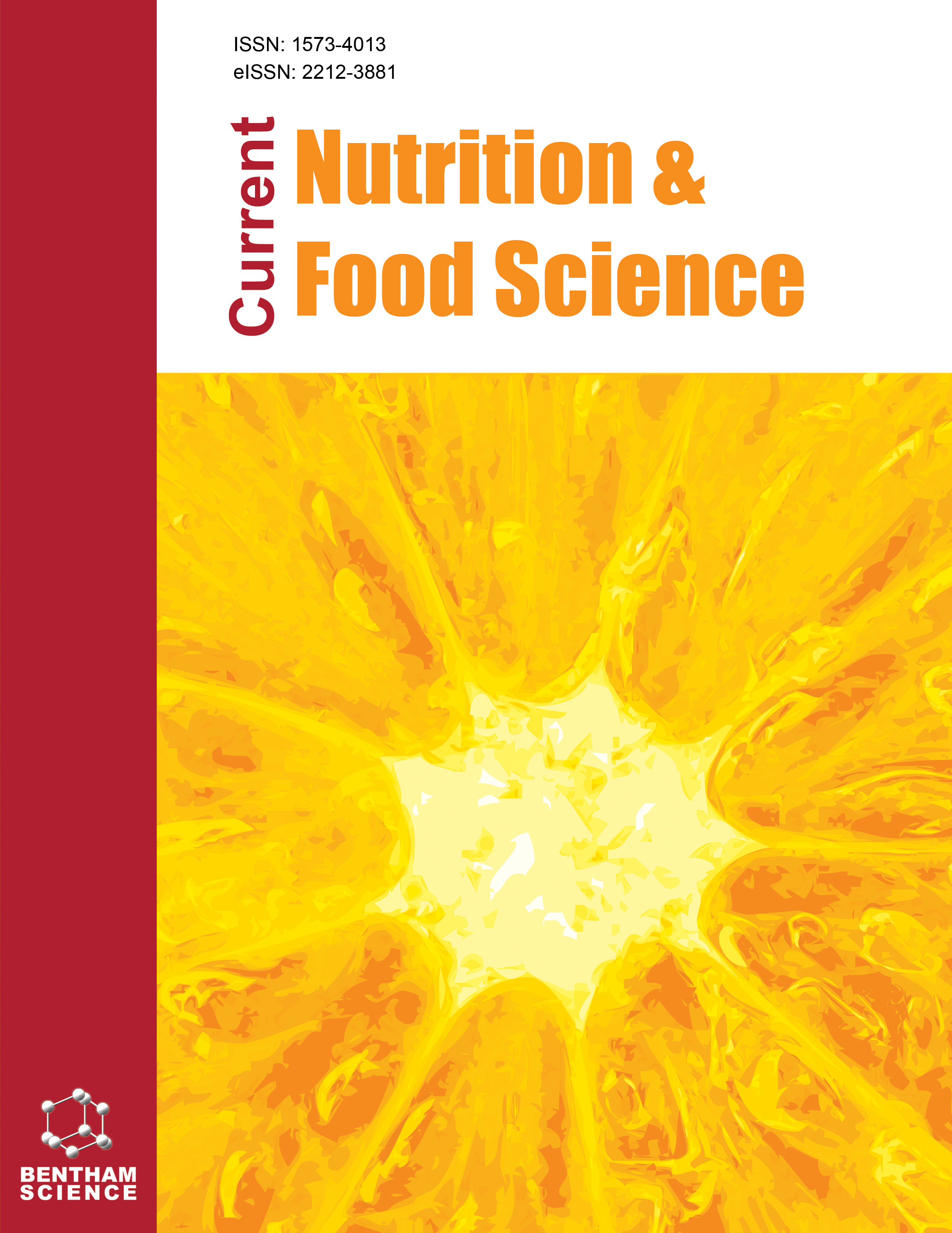- Home
- A-Z Publications
- Current Nutrition & Food Science
- Previous Issues
- Volume 9, Issue 3, 2013
Current Nutrition & Food Science - Volume 9, Issue 3, 2013
Volume 9, Issue 3, 2013
-
-
Recent Applications of Cyclodextrins as Food Additives and in Food Processing
More LessAuthors: Katia Martina, Arianna Binello, Dale Lawson, Laszlo Jicsinszky and Giancarlo CravottoNowadays the application of cyclodextrin-assisted molecular encapsulation in foods offers many advantages. Cyclodextrins, their derivatives and their cross-linked polymers can all improve the quality of food in storage, remove specific components and stabilize and increase the presence of components that are important for a healthy diet. The application of cyclodextrins and their complexes in packaging materials can help Read More
-
-
-
Study About the Knowledge and Attitudes of the Portuguese Population About Food Fibres
More LessThe association between dietary fiber, health benefits and healthy food has been studied in recent years. The food industry, to accompany the strong interest shown by consumers, has placed at their disposal new products, rich in dietary fiber. This work intended to make a statistical analysis of the knowledge of the Portuguese population about fibres, and for that a survey was conducted of a sample of 182 individuals Read More
-
-
-
Spirulina paltensis: Food and Function
More LessSpirulina and its products can be applied as feed and food additives in agriculture, food industry, medicine, science and cosmetic. It has high contents of macro and micronutrients. Several pharmacological activities for Spirulina have been documented. This review article serves as an overview, introducing medical application within each usage, the basic description of the involved disease, the mechanism of action and Read More
-
-
-
Probiotic Beverage with Soy Isoflavone Consumption for Breast Cancer Prevention: A Case-control Study
More LessThe purpose of this study is to evaluate how beverages containing Lactobacillus casei Shirota (BLS) and soy isoflavone consumption since adolescence affected the incidence of breast cancer. In a population-based case-control study, three hundred and six cases with breast cancer and 662 controls aged 40 to 55 were matched for age and residential area and included in the analyses. Diet, lifestyle and other breast canc Read More
-
-
-
The Antimicrobial Activity of Black Sour Cherry (Prunus cerasus L.) Extracts: I. Measurement of Sensitivity and Attenuation of Gram-Positive and Gram-Negative Bacteria and C. albicans in Culture
More LessAuthors: Lama B. Hanbali, Rana M. Ghadieh, Hiba A. Hasan, Yasmine K. Nakhal and John J.J. HaddadWe have previously examined the antimicrobial activity of sweet cherry (Prunus avium L.) extracts on a wide spectrum of gram-positive and gram-negative bacteria in addition to the fungus, Candida albicans. To further understand the effect of a variety of extracts of a related family of sour, tart cherries (Prunus cerasus L.) on bacterial and fungus growth, the antimicrobial activities of black sour cherry extracts (SCE) were me Read More
-
-
-
The Antimicrobial Activity of Red Sour Cherry (Prunus cerasus L.) Extracts: II. Measurement of Sensitivity and Attenuation of Gram-Positive and Gram-Negative Bacteria and C. albicans in Culture
More LessPreviously, we have examined the antimicrobial activity of sweet cheery (Prunus avium L.) extracts on a wide spectrum of gram-positive and gram-negative bacteria in addition to the fungus, Candida albicans. To further understand the effect of a variety of extracts of sour black and red cherries (Prunus cerasus L.) on bacterial/fungus growth, the antimicrobial activities of red sour cherry extracts (SCE) were measured in culture in Read More
-
-
-
The Antimicrobial Activity and MICs of Black/Red Sour Cherry (Prunus cerasus L.) Extracts: III. Measurement of Sensitivity and Attenuation of Gram-Positive and Gram-Negative Bacteria and C. albicans in Culture
More LessOn a prior occasion, we have measured the antimicrobial activities of sweet cherry extracts (SCEs) on grampositive/ negative bacteria and C. albicans using disk diffusion method, in addition to the minimum inhibitory concentrations (MICs) in broth cultures. In this study, the MICs of sour cherries were assessed @ 24 hrs. following bacterial/fungus inoculations. Extracts were subdivided into the following categories: Whole j Read More
-
-
-
Comparative Phenolic Contents and Antioxidant Activities of Myristica and Pimenta Extracts
More LessAuthors: Hao-Tam Nguyen-Luong, Allan Davison and Amandio VieiraAntioxidant activities of two commercial spices, Myristica fragrans (HOUTT, nutmeg) and Pimenta dioica (L., allspice), were analyzed for the first time in a hemin-enhanced oxidation (HET) assay. Hemin is a potentially cytotoxic factor that can act as an efficient prooxidant. Relative activities of the two spices were compared in HET and other assays. When standardized for total phenolic content (mg gallic acid equivalents, GAE), Read More
-
-
-
Simple Method for Reduction of Fluoride Concentration in Tea Infusions
More LessAuthors: Ryan L. Quock, James X. Gao and Jarvis T. ChanThis study aimed to measure the fluoride concentrations of successive infusions of tea steeped from the same tea bag, with relative risk of fluorosis in mind. 250 ml infusions of 37 different tea brands were steeped with deionized distilled water at an initial temperature 85°C. For each different tea brand, after 10 minutes the first infusion was emptied and 250 ml of fresh deionized distilled water at 85°C was added to the original Read More
-
Volumes & issues
-
Volume 21 (2025)
-
Volume 20 (2024)
-
Volume 19 (2023)
-
Volume 18 (2022)
-
Volume 17 (2021)
-
Volume 16 (2020)
-
Volume 15 (2019)
-
Volume 14 (2018)
-
Volume 13 (2017)
-
Volume 12 (2016)
-
Volume 11 (2015)
-
Volume 10 (2014)
-
Volume 9 (2013)
-
Volume 8 (2012)
-
Volume 7 (2011)
-
Volume 6 (2010)
-
Volume 5 (2009)
-
Volume 4 (2008)
-
Volume 3 (2007)
-
Volume 2 (2006)
-
Volume 1 (2005)
Most Read This Month
Article
content/journals/cnf
Journal
10
5
false
en


